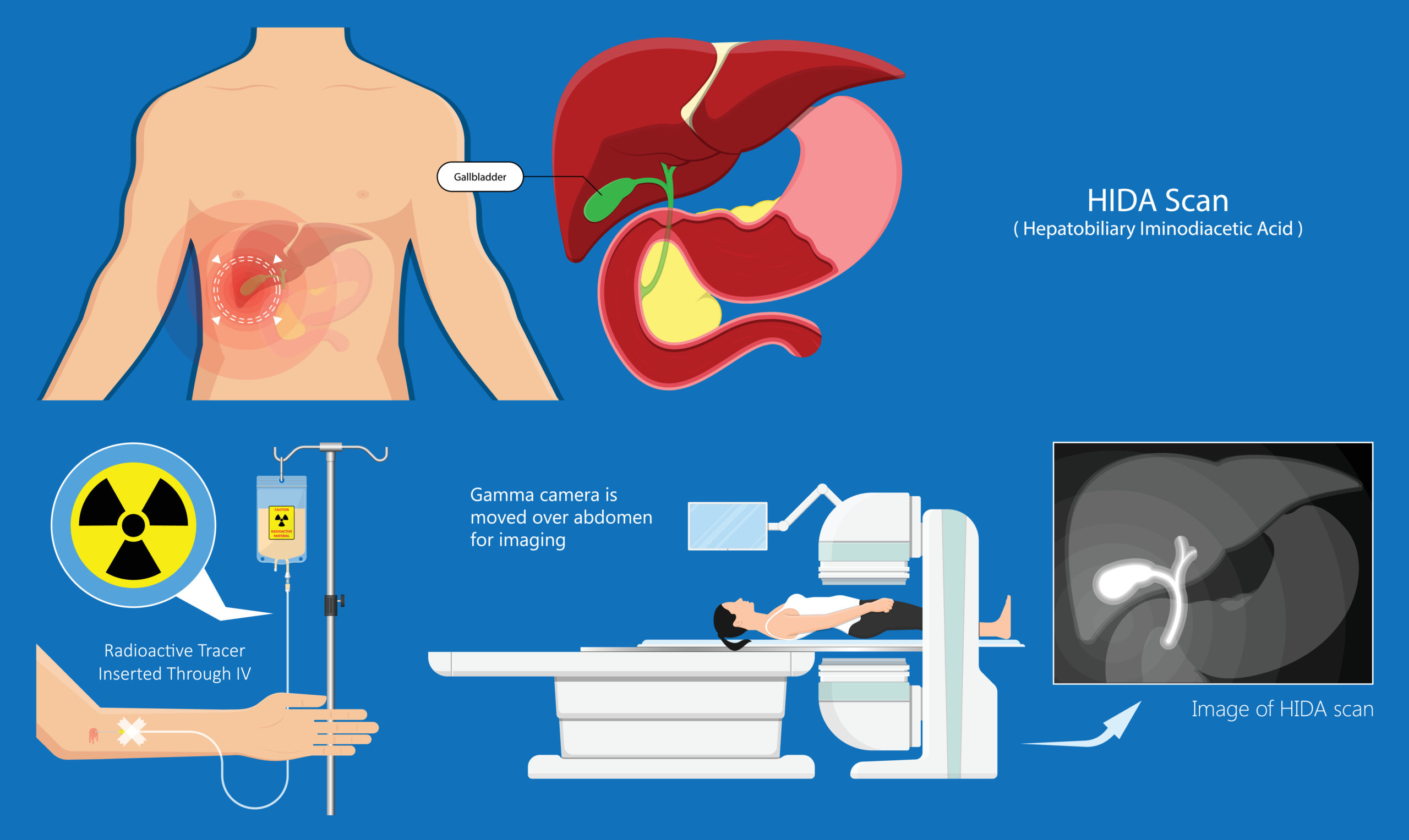hida scan Ah, the mysterious world of medical diagnostics! Ever heard of a HIDA scan? No? Don’t worry; you’re not alone. But fear not, because by the end of this article, you’ll be well-versed in all things HIDA scan-related. So, let’s dive right in!
What is a HIDA scan? Well, it’s not some secret agent lingo, although it might sound like it. HIDA stands for Hepatobiliary Iminodiacetic Acid. Essentially, it’s a nuclear medicine imaging test used to evaluate the health and function of your gallbladder and bile ducts. But why would anyone need such a scan?
How Does a HIDA Scan Work?
Picture this: your doctor suspects something’s amiss with your gallbladder or bile ducts. That’s where the HIDA scan comes into play. Here’s the lowdown on how it works:
Radioactive tracer injection: First, a radioactive tracer is injected into your bloodstream. This tracer is like a tiny spy that travels through your liver, gallbladder, and bile ducts, highlighting any potential issues along the way.
Imaging process: Next, you’ll lie down on a scanning table while a special camera captures images of your abdomen. These images allow doctors to see how well your gallbladder is functioning and whether there are any blockages in your bile ducts.
Preparing for a HIDA Scan
Before you go in for your scan, there are a few things you need to do to prepare:
Fasting requirements: Typically, you’ll need to fast for a certain period before the scan to ensure accurate results. Your doctor will provide specific instructions on how long you need to abstain from food and drink.
Medication adjustments: It’s essential to inform your doctor about any medications you’re taking, as some drugs can interfere with the results of the scan. Your doctor may advise you to stop certain medications temporarily before the procedure.
What to Expect During the Procedure
Now, let’s talk about what goes down during the actual scan:
Duration of the scan: A HIDA scan usually takes about 1 to 2 hours to complete. During this time, you’ll need to lie still on the scanning table while the camera captures images of your abdomen.
Comfort measures: Don’t worry; the scan itself is painless. You might feel a slight pinch when the radioactive tracer is injected, but other than that, it’s smooth sailing.
Interpreting HIDA Scan Results
So, you’ve had your scan—what’s next? Understanding the results, of course!
Normal vs. abnormal results: Ideally, the tracer should flow smoothly through your gallbladder and bile ducts. If there are any abnormalities, such as blockages or reduced gallbladder function, it will show up on the images.
Common findings: Some common findings on HIDA scans include gallstones, bile duct obstructions, and gallbladder dysfunction.
Conditions Diagnosed with HIDA Scans
Now, let’s get into the nitty-gritty of why HIDA scans are performed:
Gallbladder dysfunction: HIDA scans are often used to diagnose conditions like cholecystitis (inflammation of the gallbladder) and biliary dyskinesia (abnormal gallbladder function).
Bile duct obstruction: If there’s a blockage in your bile ducts, it can lead to serious complications. HIDA scans can help identify these obstructions early on.
Risks and Considerations
While HIDA scans are generally safe, there are a few things to keep in mind:
Radiation exposure: Since HIDA scans involve the use of radioactive tracers, there is a small amount of radiation exposure. However, the benefits of the scan usually outweigh the risks.
Allergic reactions: In rare cases, some people may experience allergic reactions to the radioactive tracer. Be sure to inform your doctor if you have any known allergies before the procedure.
Alternative Diagnostic Tests
If you’re not keen on undergoing a HIDA scan, don’t worry—there are alternative options available:
Ultrasound: Ultrasound imaging uses sound waves to create pictures of the inside of your body. While it’s not as detailed as a HIDA scan, it can still provide valuable information about your gallbladder and bile ducts.
CT scan: A CT scan combines multiple X-ray images to create a detailed cross-sectional view of your abdomen. It’s often used to evaluate abdominal pain and can detect conditions like gallstones and tumors.
Post-Scan Care and Recovery
After your HIDA scan, it’s essential to take care of yourself:
Resuming normal activities: You should be able to resume your normal activities immediately after the scan. However, it’s a good idea to drink plenty of fluids to help flush out the radioactive tracer from your system.
Follow-up appointments: Depending on the results of your scan, your doctor may recommend further tests or treatments. Be sure to follow up with your healthcare provider to discuss next steps.
Cost and Insurance Coverage
Ah, the dreaded topic of cost. How much does a HIDA scan actually cost, and will your insurance cover it?
Affordability considerations: The cost of a HIDA scan can vary depending on factors such as location and healthcare provider. However, it’s generally considered to be a relatively affordable diagnostic test.
Insurance reimbursement: Many insurance plans cover the cost of HIDA scans, especially if they’re deemed medically necessary. Be sure to check with your insurance provider to understand your coverage options.










